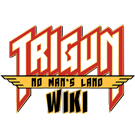No Man's Land (planet): Difference between revisions
From No Man's Land - A Trigun Wiki
no edit summary
imported>Katie5000 No edit summary |
imported>Katie5000 No edit summary |
||
| Line 1: | Line 1: | ||
{{Disambig|No Man's Land}} | {{Disambig|No Man's Land}} | ||
'''No Man's Land''' is the planet that the story of [[Trigun]] takes place on. The name is only used in the manga and Stampede continuities. The planet is unnamed in the 1998 anime continuity. | '''No Man's Land''' is the planet that the story of [[Trigun]] takes place on. The name is only used in the manga and Stampede continuities. The planet is unnamed in the 1998 anime continuity, though due to a [[Trigun: The Planet Gunsmoke|misunderstanding]] is often called "Gunsmoke". | ||
== Characteristics == | |||
No Man's Land is a large, rocky planet with a solid surface. It has at least five prominent natural satellites in orbit around it, and so can reasonably be assumed to be somewhat larger than Earth (perhaps a [https://en.wikipedia.org/wiki/Super-Earth super-Earth]). It is in a [https://en.wikipedia.org/wiki/Circumbinary_planet circumbinary orbit] around a binary star system, as evidenced by the two suns (or stars) present in its sky during the "daylight" portion of the planet's rotation. Its rotation can be assumed to be similar to that of Earth, with a 24-hour day/night cycle. However, it is unknown how long one revolution of the planet is (how long a "year" is). | |||
Atmosphere & Climate | == Atmosphere & Climate == | ||
The atmospheric composition can be assumed to be similar to Earth's, based on the way characters are able to do things like start fires, use guns, and breathe without apparatus/go outside unprotected. The source of all of the free oxygen is a mystery, however, as the planet does not have any large, plankton-containing surface oceans the way Earth does. In fact, No Man's Land is almost entirely a desert planet consisting of sand, rock, and little else. There is evidence of underground water sources such as aquifers, as many towns in the series are able to drop wells successfully (and then there's whatever Mr. Cliff had going on). Though there is little surface water at the time of the [[Trigun]] series, the underground aquifers suggest that perhaps sometime in the past, the planet was wetter and only dried recently (in geologic time). | |||
Due to the lack of surface water, the climate of No Man's Land is very dry, much like the Sahara Desert or the southwestern United States on Earth. Humidity and rain are practically non-existent, though at times it can become very windy. Sand storms are relatively common and can form storm systems akin to hurricanes or typhoons on Earth (Jacqueline, from Hang Fire). The temperature is high during the day and low at night without much water to regulate it. It is unknown if No Man's Land has official "seasons", as nothing has been said or shown in the series (yet). It is also unknown if there are different climate zones or if there is ice at the planet's poles. | |||
Cities & Culture | == Geology == | ||
== Flora & Fauna == | |||
== Cities & Culture == | |||
[[Category:Locations]] | [[Category:Locations]] | ||
